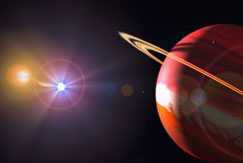Science and technology
SA astronomers in 'extraordinary' find
White and red dwarf
The two stars, referred to as a "white dwarf" and a "red dwarf", are each smaller than our Sun and are so close that they take only a couple of hours to orbit each other – the pair of them would actually fit comfortably within our Sun. By chance, the system is oriented in such a way that the stars appear to eclipse each other once every orbit as viewed from Earth. "Potter and his collaborators noticed that the eclipses were not occurring on time, but were sometimes too early or too late," the SAAO said in a statement last week. "This led them to hypothesise the presence of two giant planets whose gravitational effect would cause the stars' orbit to wobble and consequently slightly alter the measured time between eclipses."Constantly 'stealing' material
The astronomers were also able to infer that the masses of the two planets must be at least 6 and 8 times that of Jupiter and take 16 and 5 years respectively to orbit the two stars, the SAAO said. The system is too far away from us to be imaged directly. This binary star system (known as UZ For) would be an extremely inhospitable environment. Due to their close proximity, the gravity of the white dwarf is constantly "stealing" material from the surface of the red dwarf in a continuous stream. This stream crashes onto the white dwarf, where it gets super-heated to millions of degrees and subsequently floods the entire planetary system with enormous amounts of deadly X-rays. SAinfo reporter
Would you like to use this article in your publication or on your website? See: Using SAinfo material

An artist's impression of an extraordinary planetary system where two giant planets are orbiting a close pair of "suns" (Photo: South African Astronomical Observatory)
Related articles
- Africa to co-host Square Kilometre Array
- State to acquire local satellite maker
- South Africa's barefoot astronomer
- South Africa opens space weather centre
- South Africa's satellite 'leads the way'
- South Africa launches space agency
- SALT: Africa's eye on the universe
- South Africa's SKA bid 'firmly on track'
- Major milestone for KAT-7 telescope
- South Africa aims for the final frontier
- New antenna for satellite centre
- The Karoo Array Telescope




